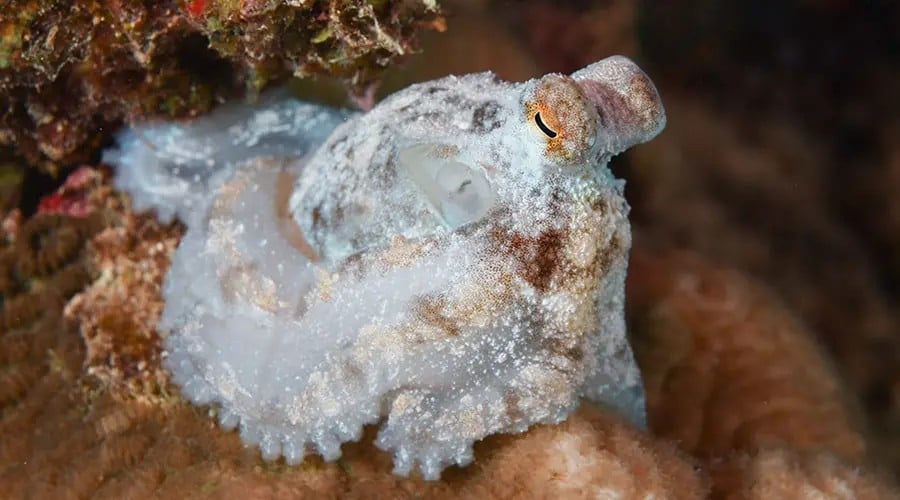Physicists and Biologists Uncover New Evidence of Octopuses’ Complex Sleep
Interdisciplinary collaborators found that the brainy cephalopods behave in their sleep like they do while awake. Are they dreaming?

Neuroscientist Sam Reiter frequently takes his students at night to catch octopuses in the ankle-deep tide pools on Okinawa, the southernmost of Japan’s main islands. But netting an octopus involves a learning curve — particularly because they change color to blend into the environment. “Usually the first time someone goes, they don't see an octopus,” says Reiter. “But people with more experience will see many of them.”
Reiter and his team bring the animals back to his lab at the Okinawa Institute of Science and Technology, where they study how the octopus’s brain activity gives rise to its complex behavior, from camouflaging itself to coordinating its many arms.
But cephalopods aren’t the only strange creatures Reiter interacts with. He also works with a physicist. Leenoy Meshulam, a postdoc and physicist at the University of Washington, collaborates with Reiter across the Pacific Ocean.
The team recently found that, during a particular stage of sleep, octopuses exhibit color patterns and neural activity similar to those they exhibit while awake. Their conclusions, presented at the APS March Meeting this year and published in Nature on June 28, are based on extensive image analysis of multiple octopuses’ skin patterns and electric measurements of their neural activity. The team hypothesizes that octopuses could be reliving their waking experiences, such as hiding from a predator, and exhibiting the skin pattern associated with the experience, in a behavior akin to dreaming — though this is far from certain.
Octopuses are unusual among invertebrates because they experience two-stage sleep, like vertebrates. In two-stage sleep, the animal experiences a stage called active sleep and a second, quieter stage. In vertebrates, this stage is often called slow-wave sleep, or deep sleep. (Humans dream during active sleep, also known as the rapid eye movement stage; during slow-wave sleep, the body repairs and regrows.)
Other invertebrates, such as insects and worms, generally undergo a single sleep stage. “They just have one kind of sleep where the brain just kind of goes quiet,” says Reiter.
This implies that octopuses have evolved two-stage sleep independently of vertebrates, which suggests that active sleep could be a “general feature of complex cognition,” says Meshulam.
The research is right up Meshulam’s alley. She’s working to develop theoretical frameworks to describe the octopus’s behavior. “My jam in life is to study things that have multiple scales,” she says. In organisms, the scales span the macroscopic — such as the octopus’s behavior in response to a predator — to the microscopic, such as the pigment granules inside cells involved in camouflage called chromatophores.
Meshulam contacted Reiter to begin collaborating three years ago, after she read a paper of his on camouflage in cuttlefish. “I looked at this paper and thought, 'This is the best,’” she says. “I like emergent phenomena. In an octopus, 100,000 chromatophores collectively coordinate to give rise to macroscopic behavior.”
Collaborations between physicists and life scientists have become increasingly common, as has research in biological physics, which stretches from the mechanics of DNA to the study of animal behavior. In 2022, the National Academies released the first-ever decadal survey of biological physics, a signal of the field’s maturity. In March 2023, APS launched PRX Life, the first interdisciplinary journal focused exclusively on quantitative biological research. Writing in APS News in April, William Bialek of Princeton University argues that core physics curricula should incorporate more biological concepts. “Physics reaches far beyond the world of inclined planes, isolated atoms, and ideal gases, to life itself,” writes Bialek, a pioneer of the field.
Physicists bring a new angle to biology research, says Reiter. “I find physicists’ emphasis on general principles refreshing,” he says. “Biologists put a lot of emphasis on the nitty-gritty details.”
By contrast, physicists tend to look at how a behavior might occur across many organisms, an approach Meshulam describes with an analogy. A tornado is different from a whirlpool that forms as a bathtub drains — the former is gas and dust, the latter water — but the Navier-Stokes equation describes both. Similarly, Meshulam searches for principles that apply to different organisms, regardless of their biological mechanisms.
But physicists can have their own biases. “They love power laws,” Reiter says, referring to a physicist’s propensity to search for specific mathematical relationships in organisms. “From my perspective, sometimes it’s useful, and sometimes it’s not.”
It can be challenging to communicate with biologists, “but you learn so much,” says Meshulam. She’s found, for example, that biologists and physicists may use different terminology to describe similar concepts.
Physicists predict the likelihood of a specific electron spin state using the concept of an “effective field,” which describes the forces that act on the particle in a crystal. Meshulam found the same concept in biology, called “conditional probability,” which describes the likelihood of an outcome based on previous events. She has used this to predict a neuron's state from the activity of those around it. Finding related ideas has helped her focus on the “essence” rather than the “lingo” of science, she says.
These collaborations are changing what qualifies as fundamental science in physics. “We need new math and physics to understand how biology works,” she says. Living systems inhabit a distinct regime, beyond the frameworks of particle and condensed matter physics. Quantum mechanical activity, as in photosynthesis, directly affects macroscopic activity, such as a flower blooming.
“The exciting and terrifying thing about this field is that we don’t even know the right questions to ask,” says Meshulam. “We need to figure out not just how to calculate something, but what we should calculate.” It’s a fruitful time to join the field.